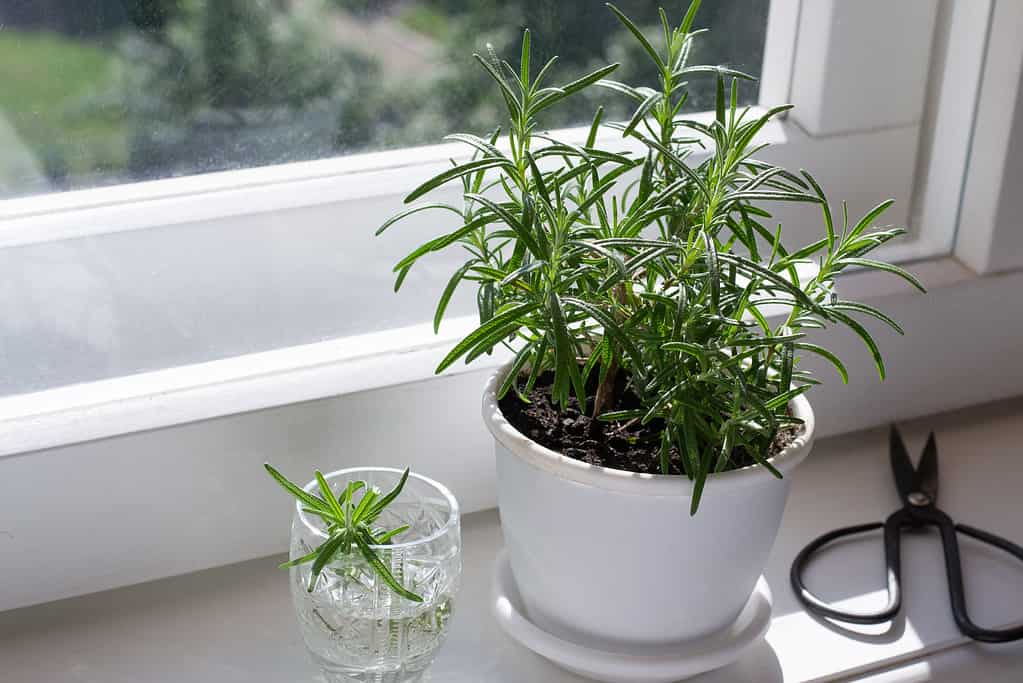Can rosemary survive winter? The short answer is yes. As the mercury drops and the colder months set in, the challenge of preserving this aromatic herb becomes another gardening adventure. The art of overwintering rosemary requires patience and a little luck. However, it’s not as difficult as you may have been led to believe. Continue reading to discover five tips for keeping your favorite herb alive through winter.

Rosemary leaves are 0.5 to 2 inches long, narrow, and usually dark green on top.
©Hulya Poyraz/Shutterstock.com
What is Rosemary and Can it Survive Winter?
Rosemary (Rosmarinus officinalis) is an evergreen herb belonging to the mint family, Lamiaceae. It is native to the Mediterranean but is now cultivated around the world. Rosemary is a fragrant, woody shrub with needle-like leaves. The leaves are 0.5 to 2 inches (1.25 to 5 cm) long, narrow, and usually dark green on top, while the undersides may appear white or gray due to the presence of fine hairs. The most distinctive feature of rosemary is its delightful fragrance. The leaves emit a strong, piney, slightly peppery aroma, which intensifies when crushed or rubbed. Rosemary has been studied for its potential health benefits, including anti-viral properties. Research suggests that rosemary extracts exhibit inhibitory effects against herpes simplex virus (HSV) and influenza. Steeped in boiling water, rosemary leaves make a dandy tea that may stave off illness.

Steeped in boiling water, rosemary leaves make a dandy tea that may stave off illness.
©svf74/Shutterstock.com
1. Light
Rosemary is a hardy perennial that can survive temperatures as low as 10°F (-12° C). Therefore, it generally thrives outdoors in USDA Hardiness Zones 7 to 10, where it can grow into a large shrub. In colder climates, it’s best to grow rosemary in containers that can be overwintered indoors. However, there is more to overwintering your rosemary indoors than simply bringing the pot inside. Some things you will need to consider are light, temperature, airflow, humidity, and moisture.
The first consideration when moving your rosemary indoors is light. Rosemary requires at least six to eight hours of full sun every day. In the Northern Hemisphere, south-facing windows are generally the sunniest. A room with windows on the south side and ample sunlight is the most important consideration. Without sufficient light, your plant will drop its leaves. Unless you have a super bright room with windows on more than one wall, it’s best to place your plant within a foot of the window.

It’s best to place your rosemary plant within a foot (30 cm) of the window.
©Albina Yalunina/iStock via Getty Images
2. Temperature
Once you have determined the winter home for your rosemary, the temperature is the next obstacle to tackle. Chances are your rosemary plant prefers a cooler indoor climate than most folks are going to be comfortable with. It seems a bit counterintuitive since your plant has endured the scorching heat of summer. However, in the winter rosemary enters a period of dormancy, in which the plant suspends its growth. This is why, once brought inside, your rosemary plant requires cooler temps than you’d expect. Daytime temperatures between 60°- 65° F (15.5° – 18° C) are optimum. You’ll want to keep it 10 degrees cooler at night. We’re talking, 50°- 60° F (10°- 15.5° C). This obstacle is easily addressed by closing the vents and keeping the door closed to the room in which you are overwintering your rosemary. If space is at a premium in your home, layer up!
3. Airflow
Closed vents and doors help keep the room in which you are overwintering your rosemary in the proper temperature range. However, these same closed vents and doors present an obstacle to air circulation, which is crucial to the well-being of your plant. Providing adequate airflow is essential to mimic the plant’s natural conditions and prevent issues associated with stagnant air, such as fungal diseases. The addition of a small circulating fan will address any circulation issues. Place the fan in a location that allows air to flow freely through the room without blowing directly on your rosemary plant.
4. Humidity
Rosemary is well-suited to drier conditions, and high humidity can lead to problems such as root rot and fungal diseases. The optimal humidity for overwintering indoor rosemary is relatively low, typically between 40-50%. This is relatively good news and easy to accomplish, as the average home humidity hovers around 40%, unless your home has a humidifier. Keeping the humidity relatively low allows the soil to dry out between waterings.
5. Moisture
Once the above conditions have been met, the only thing left to consider is moisture. In winter, when rosemary is dormant, it requires less frequent watering than during the growing season. Aim for a balance, keeping the soil consistently slightly moist but not overly wet. It’s always better to underwater than overwater, as rosemary is more tolerant of drought conditions than waterlogged soil. Adjust your watering routine based on the specific needs of your plant and the conditions in your home. An occasional misting with water may be warranted if the humidity in your home is consistently lower than 40%.
Following the above tips, your rosemary plant should survive the winter to see another spring.
Thank you for reading! Have some feedback for us? Contact the AZ Animals editorial team.








